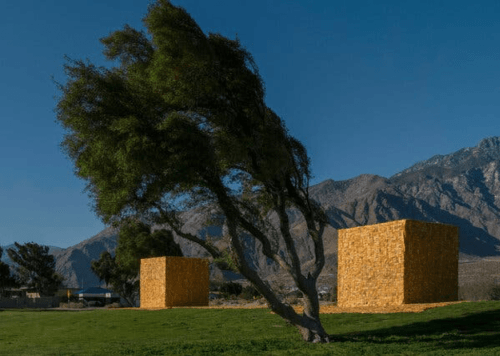
This pair of yellow-orange cubes recalls from a distance a fan favorite from the last Desert X: Sterling Ruby’s bright orange rectangular prism set against the desert terrain. But that was a slick geometric form appearing incongruously and improbably in the craggy landscape (not unlike the unidentified monolith found last year in Utah that inspired a thousand conspiracy theories), while Clottey’s humble choice of material speaks to the droughts and water supply issues that threaten Southern California as well as his native Ghana. He cuts plastic pieces from so-called Kufuor gallons, colorful containers used in Ghana for storing water, and stitches them together with wire. He has previously used this material to fabricate everything from flags to a yellow brick road. Here the boxy forms, planted in grass outside a Palm Springs community center, evoke water tanks, and the plastic blanket below them spreads out like much-needed water.
Desert X Artists Dig Beneath the Sandy Surface
Artworks in this year’s biennial, scattered around the Palm Springs area, explore issues of land rights, water supply and more.
By Jori Finkel
Published March 12, 2021 (Updated March 13, 2021)
PALM SPRINGS, Calif. — The odds were fully stacked against the Desert X biennial taking place this year. Bigger and better-organized destination exhibitions have punted on their plans since the pandemic struck, and even in the best of years, Desert X, which commissions site-specific public art in and around Palm Springs, has a hard time raising money to realize its projects. Its decision two years ago to accept funding from the Saudi Arabian government for a spinoff event caused prominent board members to resign and artists to speak out in protest.
And the guest curator chosen for the 2021 edition, César García-Alvarez, fell ill with Covid-19 last year, just as he began working with artists to develop their projects. “I was very sick from mid-March through the end of May, and I still am; I’m a Covid long-hauler,” he said.
“It was hard organizing a show like this during a pandemic, I think we’re all very honest about that,” he added. “But it was important we continue to do this and continue supporting artists.”
Neville Wakefield, who is Desert X’s artistic director and co-curator of its third edition, agreed. “We never considered canceling it,” he said of the show, which opens on Friday. “Just the opposite. The fact that we’re outdoors and free to the public made our purpose more urgent in some respects. While museums in L.A. have been closed for a year, we felt a responsibility to do what our walled institutions couldn’t and nourish the need for culture.”
The biennial is smaller than usual, featuring the work of 13 artists compared with as many as 19 in years past, with a more compact footprint. “We weren’t sure if hotels would be open, so we organized a show that someone from L.A. or San Diego could drive in to see in a day,” said García-Alvarez. (They are installing hand-sanitizing stations at some artworks and “health ambassadors” at others to distribute masks and ensure social distancing.)
The show features work by several international artists, including Alicja Kwade from Berlin, Serge Attukwei Clottey from Accra, Ghana; Oscar Murillo from La Paila, Colombia; Eduardo Sarabia from Guadalajara, Mexico; and Vivian Suter from Panajachel, Guatemala. Most have showed at the Mistake Room, the nonprofit exhibition space García-Alvarez founded. His original idea was to help Desert X artists work with community organizations in Palm Springs and other Coachella Valley towns, but Covid-19 safety protocols largely scrambled those plans as well.
Still, most artworks are rooted in some sense of place. “The desert is not an empty void,” he said. “So you will see the artists here responding not just to the physical landscape but to environmental and social issues, whether it’s Felipe Baeza’s mural on the history of undocumented migrants and queer communities of color in the desert or Serge Attukwei Clottey’s installation dealing with issues of water access or Xaviera Simmons’s billboards looking at the way the desert perpetuates notions of whiteness.”
Works by Baeza, Murillo and Christopher Myers are for different reasons scheduled to go public after the show’s official opening, while plans for an ephemeral “smoke sculpture” by Judy Chicago are uncertain. (Since the Living Desert has pulled out as her venue, she has been looking for a new location and on Friday said, “We couldn’t find one.”) Of the artworks already installed, here are five well worth the drive.